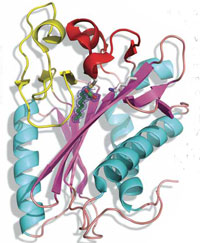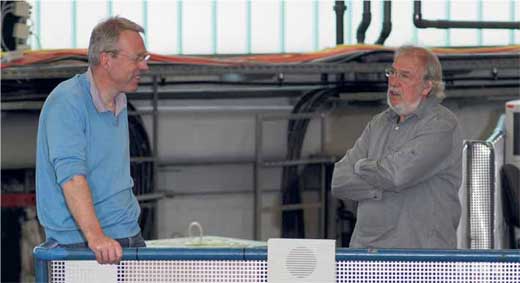Fighting an old enemy: tuberculosis Understand article
Tuberculosis isn’t something Europeans normally worry about. But the disease is re-emerging and is resistant to many of our drugs. Claire Ainsworth describes how Matthias Wilmanns and his team are trying to hold the disease back.

the tuberculosis bacterium
Image courtesy of Qingjun Ma, EMBL
“Che gelida manina” – How cold your little hand is. Rodolfo, an impoverished artist in Puccini’s opera, La Bohème, sings a love song to Mimi, a girl he has just met. The two characters meet in a garret in 1830s Paris, enchanting the opera’s audience with their touching love story. But the relationship is doomed: Mimi has tuberculosis and gradually perishes, coughing and cold. In the final scene, when a grief-stricken Rodolfo casts himself over Mimi’s deathbed, crying out her name, there is scarcely a dry eye in the house.
Even so, La Bohème, written in the 1890s, has lost some of its impact for a modern European audience. Much as we might sympathise with poor Rodolfo, the idea of someone actually dying from tuberculosis (TB) seems a little unreal. In our modern age of vaccines and antibiotics, it feels like a disease from a bygone age. Indeed, in the 1950s and 1960s, such was the success of antibiotic therapy that many experts predicted that TB would be eradicated worldwide.
But two things have weakened our therapeutic defences against TB. The first was that patients often failed to complete their courses of antibiotics. The second was the arrival of the global HIV epidemic, which decimated the immune systems of millions worldwide. As a result, TB had the opportunity to develop drug resistance, and did so with alarming rapidity.
Soon, strains of the bacterium appeared that resisted one or more antibiotics. Now, a highly lethal form, dubbed XDR-TB for ‘extremely drug-resistant TB’, has emerged, which resists nearly all antibiotics – one strain has been found that resists them all. If it became widespread, such a strain could render doctors as helpless to treat patients as they were in the 1800s. “It’s alarming,” says Matthias Wilmanns, head of the European Molecular Biology Laboratory (EMBL) in Hamburg, Germany. “The emergence of the XDR-TB strain is a major problem.”
Matthias heads a project that forms part of biomedical science’s counter-offensive against TB. The X-MTB project is run by a consortium of academic and industrial institutions in Germany, and is co-ordinated by EMBL Hamburg. It aims to discover the structures of TB proteins that are promising candidates as drug targets. And new drugs are desperately needed; no new therapies to tackle TB have been brought to the clinic for more than 40 years.
Matthias’s team is part of a global effort to apply structural genomics – the science of determining the structure of every protein encoded in an organism’s genome – to Mycobacterium tuberculosis, the bacterium that causes TB. Whereas the largest consortium, the US TB Structural Genomics Consortium, has taken a broad approach and is scanning the entire genome, Matthias and his collaborators have focused their efforts on finding structures for proteins that have already been singled out as promising drug targets. Knowing a protein’s structure is invaluable to drug developers, because they can design drugs to interact with the key working parts of the protein.

Image courtesy of EMBL Photolab
The X-MTB project began in 2003, funded by the German Ministry for Science and Education. With the help of consortium member Stefan Kaufmann of the Max-Planck Institute of Infection Biology, the team selected 242 proteins to study. Of particular interest were proteins that are involved in TB’s ability to survive in the body for decades.
About one-third of the world’s population is infected with TB, with the majority harbouring dormant infections that are kept in check by the body’s immune system. As many as three million people die each year from acute infection or dormant disease that has become reactivated. This dormancy or ‘latency’ is a particular problem because most antibiotics only kill bacterial cells that are actively dividing. So finding drugs that inhibit TB’s long-term survival in the body is a key goal.
To date, the X-MTB project has been remarkably successful. Thanks to its experimental and technological setup, the team has disproved a long-standing dogma in X-ray crystallography that it was only possible to attain a structure determination efficiency of 10 percent. “We have shown that it is possible to get about a third of all targets selected, purified and crystallised,” says Matthias.
Key to this success was the open-access, high-throughput crystallisation facility at EMBL Hamburg, coupled with the innovative system the team used to produce the proteins. “The conventional wisdom was that it was very difficult to get structures,” says Matthias. “With this project, we have been able to show that if you produce a good pipeline, you can get almost too many structures.”
Thanks to these efforts, the X-MTB team has produced structures for 35 key TB proteins so far. The function of many of these was unknown, but the consortium has already made good progress in working out what some of them do. In a number of cases, the structure has actually helped to reveal the function of the protein.
One such case is LipB, an enzyme involved in producing the co-factors TB needs to grow and survive. Stefan singled it out as being a key target when his team found the enzyme was extremely active in infected human cells, especially those infected with multidrug-resistant TB. So Matthias’s group set to work making and studying crystals and determined its structure. This revealed, unexpectedly, that there was another small molecule called decanoic acid attached to the enzyme. Further studies showed that this formed part of LipB’s active site and allowed Matthias and his team to deduce what kind of chemical reactions took place there, and from this, to work out what the enzyme does. ”It’s a kind of classical functional discovery, based on structure,” says Matthias. Further work will be needed to see whether it is possible to block this process with drugs, he adds.
Other important avenues of attack include the sensing systems that TB uses to probe and respond to its environment. Such systems are poorly understood. One, called the PrrA-PrrB system, helps the bacterium replicate and survive inside macrophages, the immune cells it infects, and is an obvious target for drug therapy. Last year, EMBL Hamburg scientists, led by group leader Paul Tucker, published the structures of the two proteins, PrrA and PrrB, that constitute this system. This work revealed how the structures of the proteins change as they interact – information that will prove invaluable for scientists designing chemicals to inhibit that interaction.
But such discoveries will not make a difference unless ways can be found to translate them into therapies. Historically, the pharmaceutical industry has not been terribly interested in developing TB drugs as it is perceived as a disease of developing countries – countries that are too poor to buy enough drugs to allow companies to recoup the considerable costs of developing them, let alone to make a profit.
Now, says Matthias, there are encouraging signs that things might be changing. He is involved in efforts to find new ways of funding TB drug development, such as securing European Union funding and possibly collaborating with labs in India and other developing nations. Even pharmaceutical companies are starting to show more interest, he says, now that China and India are set to become major economic powers.
Because TB does not respect national borders, it would be a mistake for developed countries to ignore the threat. TB is a global disease that requires global action, lest it return, incurable, and make the sad tale of Mimi and Rodolfo strike a chord with Western audiences once more.
Resources
- Holton SJ, Weiss MS, Tucker PA, Wilmanns M (2007) Structure-based approaches to drug discovery against tuberculosis. Current Protein & Peptide Science 8: 365-375
- Ma Q, Zhao X, Nasser Eddine A, Geerlof A, Li X, Cronan JE, Kaufmann SH, Wilmanns M (2006) The Mycobacterium tuberculosis LipB enzyme functions as a cysteine/lysine dyad acyltransferase. Proceedings of the National Academy of Sciences USA 103: 8662-8667
- Nowak E, Panjikar S, Morth JP, Jordanova R, Svergun DI, Tucker PA (2006) Structural and functional aspects of the sensor histidine kinase PrrB from Mycobacterium tuberculosis. Structure 14: 275-285
- Nowak E, Panjikar S, Konarev P, Svergun DI, Tucker PA (2006) The structural basis of signal transduction for the response regulator PrrA from Mycobacterium tuberculosis. Journal of Biological Chemistry 281: 9659-9666
Institutions
Review
The article provides a good account of the recent developments regarding tuberculosis (TB), including details of the re-emergence of the disease as a major threat to humanity, as well as the global efforts underway to find a cure. Apart from providing scientific information on the strategies and methodologies that biologists use to tackle TB, the article offers the opportunity to discuss:
How one disease can have a drastic effect on the evolution of another disease.
How modern science recognises no geographical borders, and therefore, solutions to scientific problems are often found as a result of collaborations between scientists from around the world.
How different scientific groups adopt different research strategies in their effort to discover important information that will help fight a disease.
The criteria that companies use when deciding whether or not to fund the research needed to find a cure for a specific disease.
Michalis Hadjimarcou, Cyprus





